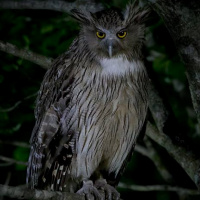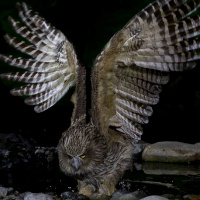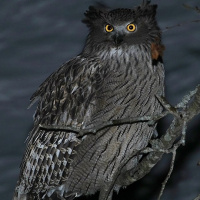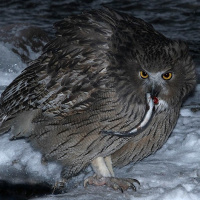Introduction
The Blakiston's Fish Owl is a very large owl with broad, almost horizontally slanting, tousled ear-tufts. It is also known as the Blakiston's Eagle Owl.
Photo Gallery (4 pictures)
Sound Gallery
Information
Description: The facial disc is tawny-brown with narrow black shaft-stripes, and lacks a distinct rim. The iris of the eye is yellow and the
bill is greyish. There is a row of small, stiff, whitish feathers above the eyes, around the base of the bill and on the forehead. The chin is largely white.
The rest of the head and upperparts are brown with blackish-brown shaft-stripes and buff feather tips. The back is darker, the hind neck has traces of barring,
and the mantle is paler and more rufous with blackish-brown bars as well as dark brown shaft-streaks.
The wings are deep brown with many buffish-yellowish bars. The tail is dark brown with 7-8 cream-yellow bars. The undertail-coverts are cream-coloured with a
few dark markings.
Underparts are pale buffish-brown with blackish-brown shaft-streaks and narrow light brown wavy cross-bars. Feathers of the underparts are pale ashy at the base.
Tarsi are feathered, mostly unmarked and cream-coloured. Toes are bare and lead-grey. Claws are dark horn.
Size: Length 60-71cm. Wing length 498-560mm. Tail length 243-286mm. Weight males 3.1kg average, females 3.25kg average (these are late winter weights, so are likely a yearly low), highest weight recorded 4.6kg. Females are larger than males.
Habits: Usually hunts at the onset of dark, but also reported to be active at dusk. May also hunt during the day and night in the brood-rearing season. Blakiston's Fish Owls spend much of their time on the ground, to the point of trampling out trails along river banks.
Voice: A short, deep boo-boo uoo or foo-foroo. Pairs apparently engage in elaborate duets. Food begging call of the young is a long drawn-out and slurred trill - pi-prrir-pirrr...
Hunting & Food: As their name suggests, Blakiston's Fish Owls feed mainly on fish, sometimes of a considerable size: Amur pike, catfish, burbot, trout, salmon as well as crayfish. They will also take frogs, which are sometimes fed to young in large quantities. In Winter, mammals are also taken, such as hares and martens. Aquatic prey is captured my entering the water and wading through the shallows, or by standing in wait at the water's edge and pouncing on prey. They also snatch fish from the water while in flight in the manner of a Sea-eagle.
Breeding: Nests in large tree hollows 2-18 metres above the ground, and will readily take to artificial nest boxes. Blakiston's Fish Owl does not necessarily breed every year, most likely as the result of food supply limitations and weather conditions. Courtship occurs from January to February. Egg laying begins as early as mid March, when the ground and trees are still covered with snow. Clutch size is 1-3, normally 2. Eggs are completely white, measuring 61 x 48.5mm to 62.4 x 49mm. The female incubates the eggs alone, while the male provides the food. The incubation period is about 35 days. Young leave the nest within 35-40 days of hatching, and fledge at about 50 days. Juveniles remain dependant on their parents for some months, and remain in their natal territory into their second year.
Mortality: Most known Blakiston's fish owl mortality is due to contact with humans. They are shot by hunters, and in winter, fish owls are accidentally caught in furbearer snare lines.
Habitat: Riverine forest and coniferous forest, chiefly along fast-flowing rivers and streams that remain at least partly ice-free in winter. Dense coniferous, mixed and broad leaved forest in wide river plains offering islands in fast-flowing waters and permanent springs that do not freeze over. In the Kuriles, inhabits dense fir and spruce forest with some deciduous trees bordering lakes, river mouths and sea coasts.
Distribution: Russian far east, including Sakhalin Island, south through northeastern China to South Korea. Also present on Hokkaido (north island of Japan), and nearby islands.
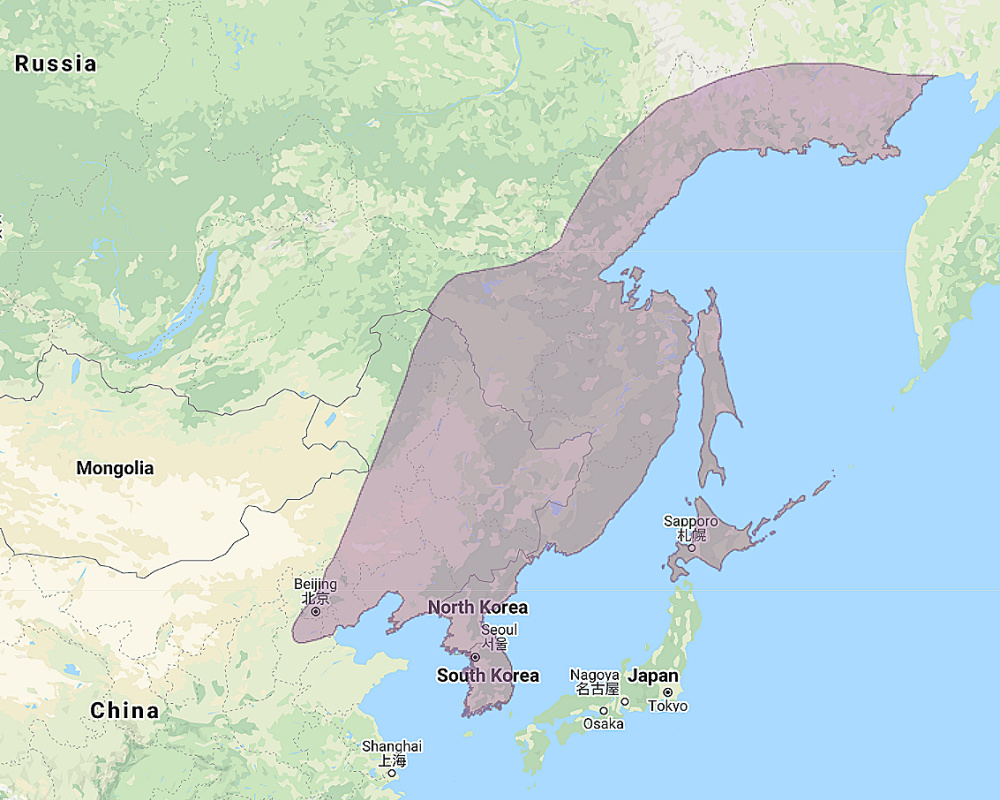
Range of the Blakiston's Fish Owl Bubo blakistoni
Status: Listed as Endangered by Birdlife International.
Original Description: Seebohm, Henry. 1884. Ibis, 5th Series, vol. 2: p. 42.

